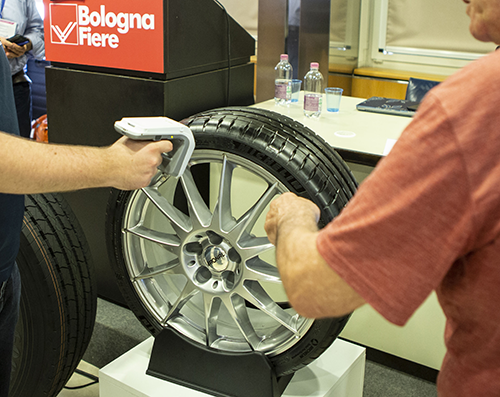Cars, trucks, buses, and heavy-duty vehicles are increasingly connected: now mostly with operation centres and, in the near future, with each other as well. Their tires, up until very recently, were the only components unable to communicate with on-board networks, with the exception of a few Tpms data. In order to track their every stage of life, generating enough data for vehicle and tire fleet analysis, an effective and simple idea was born: a unique identification number that can track each casing regardless of the region of the world where it was built and serviced. The identification number is the only information contained by the passive chip that can be read by a radio frequency system. The interaction between management system and casing is simple and universal and remains valid through any hardware and software upgrade. Tire builders and fleet systems, once received the information, will exchange it and associate tire parameters with the number: technical data, number of retreads, mileage covered by the casing (which can be obtained by interacting with the vehicle's on-board computer systems), routine and extraordinary vehicle maintenance, and geolocation, which opens up interesting prospects in managing future recalls.
Permanent identity “for life”
 As the system was introduced to specialists through a special conference at Autopromotec, the initiative was welcomed by Airp, whose president Stefano Carloni remarked on the advantages for the retreading supply chain: "From the 1930s to the present, the information about the life of a tire that reached us retreaders has always been the same. Now Rfid opens up new and interesting possibilities for us." "The hardware of the system," explains Christophe Duc, Rfid Initiative and Service Model leader at Michelin, "is reliable and robust: it’s a chip installed between two layers of rubber, which remains readable even on a very damaged tire." The system, which is impervious even to extreme weather patterns and impacts with sidewalks and potholes, replaces the familiar labels and markings found on the sidewall of the tire. The hardware can be recycled, and its super-lightweight does not create any balancing problems; the passive system makes the data readable even with the vehicle in motion, for example at the entrance of depots and workshops.
As the system was introduced to specialists through a special conference at Autopromotec, the initiative was welcomed by Airp, whose president Stefano Carloni remarked on the advantages for the retreading supply chain: "From the 1930s to the present, the information about the life of a tire that reached us retreaders has always been the same. Now Rfid opens up new and interesting possibilities for us." "The hardware of the system," explains Christophe Duc, Rfid Initiative and Service Model leader at Michelin, "is reliable and robust: it’s a chip installed between two layers of rubber, which remains readable even on a very damaged tire." The system, which is impervious even to extreme weather patterns and impacts with sidewalks and potholes, replaces the familiar labels and markings found on the sidewall of the tire. The hardware can be recycled, and its super-lightweight does not create any balancing problems; the passive system makes the data readable even with the vehicle in motion, for example at the entrance of depots and workshops.
A revolutionary step similar to the one experienced years ago by chassis numbers, when these switched from individual manufacturer numbering to Vin, which is universal in the form and meaning. To bring it about, Bridgestone, Continental, Goodyear, Michelin and Pirelli joined together in the Gdso (Global Data Service Organization), a Brussels-based European non-profit organization responsible for setting the standards for data interchange. "The serial number," explains secretary general Riccardo Giovannotti, "is engraved on a chip that operates in read-only mode and is therefore impossible to temper with. Decoding it gives access to data saved in a cloud that describe the tire's characteristics (manufacturer, size, homologations, labelling...), entered by the manufacturer, and its operational life (retreading and regrooving in particular), entered by the aftermarket supply chain and fleet managers." New scenarios are also opening up for workshops as equipment capable of reading Rfid data and thus able to interact with tires are already available in the market.
Simple and accurate logistics
The digital identity of the tire simplifies its management during every stage of its life including the logistics involved from construction to stock management, mounting the tire on the vehicle (including compatibility with the latter and matching it to the chassis number), maintenance, retreading and other after-sales services, operation and related warranty and claims management. It also allows easy traceability in the research and development stages of both the tire itself and the vehicle, a combined analysis of the tire data with those of the vehicle (position detected via GPS, pressure detected by the Tpms, speed and steering angles read on the Can-Bus...), and finally it helps the circular economy because those who recycle the tires know all the data related to the type of compounds with which it was made. Under study by Gdso is the possibility to open data to independent retreaders, which will make it possible to track the operating life of the tire even when it leaves the official supply chain of its manufacturer. The technology, which is already market-ready to the extent that more than 60 percent of industrial vehicle tires are already equipped with it, is spreading to light-duty tires as well.


